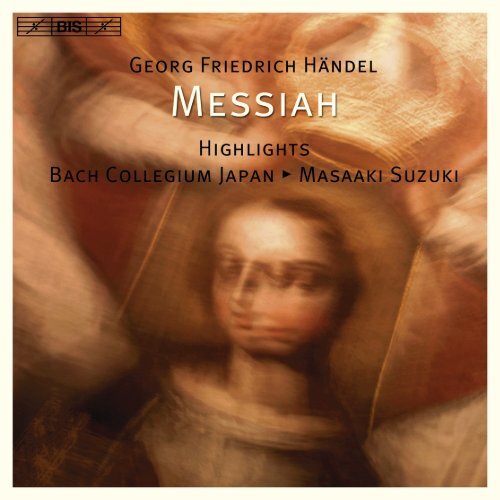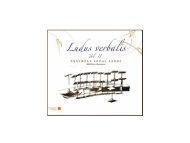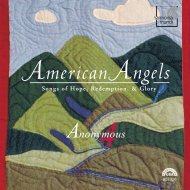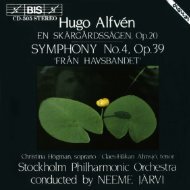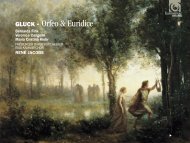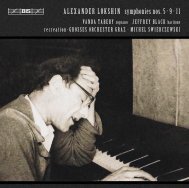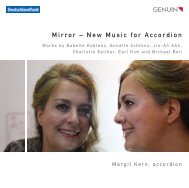Album booklet - eClassical
Album booklet - eClassical
Album booklet - eClassical
Create successful ePaper yourself
Turn your PDF publications into a flip-book with our unique Google optimized e-Paper software.
HAN D EL, G EoRG Fnt eoentc+ (7685-775s)<br />
Highlights from<br />
M ess rnH<br />
in a recording based on Handet's own performance of the work at Covent Garden in 1253<br />
Text: compiled by Charles Jennens from the Bibte and Prayer Book Psatter<br />
Pnnr rxE Frnsr<br />
tr And without controversv narrator<br />
tr Symphony<br />
El Comfort ye my people tenor<br />
tr Ev'ry valley shatl be exalted renor<br />
tr And the glory ofthe Lord shatt be revealed chorus<br />
tr Behotd, a virgin shall conceive alto<br />
tr O Thou that tetlest good tidings toZion alto, chorus<br />
E For unto us a child isborn chorus<br />
tr And suddenly there was with the angel soprano<br />
@ Gtory to God in the highest chorus<br />
E Rejoice greatly, O daughter ofZion soprano<br />
Pnnr rne Secoruo<br />
tr Behotd the Lamb of God chorus<br />
E He was despised and rejected of men a/fo<br />
tr Surety, He hath borne our griefs chorus<br />
tr And with His stripes we are heated chorus<br />
tr Atl we like sheep have gone astray chorus<br />
tr Hattetujah! chorus<br />
0'36<br />
3',07<br />
2'55<br />
3',75<br />
2'48<br />
o'29<br />
5'36<br />
3',46<br />
o'75<br />
7'47<br />
4'72<br />
3'77<br />
tt'04<br />
7'49<br />
7'34<br />
5 )l<br />
3'29
Pnnr rur Tsrno<br />
El I know that my Redeemer liveth soprano<br />
tr Since by man came death chorus<br />
@ Behold, I tell you a mystery boss<br />
E The trumpet shall sound bass<br />
tr Worthy is the Lamb that was slain chorus<br />
Bncn Colt-EGtuM Jnpnru orchestro ond choir<br />
Mnsnnrt Suzurt director<br />
Sotorsrs:<br />
Mtoont Suzurt soprano ' Yosntrnzu Menna/to<br />
Jonn Elwes tunor/narrator ' Dnvto THotuns bass<br />
5'37<br />
2',04<br />
0'39<br />
8'48<br />
7'07<br />
IT:78'45
Few works in the history of music have become so widely known and loved<br />
during the composer’s own lifetime as Handel’s Messiah. C.P.E. Bach, W.A.<br />
Mozart and Ludwig van Beethoven were all familiar with this great work either<br />
as listeners, performers or arrangers and they all held its composer in high esteem.<br />
Even in the eighteenth century, enthusiastic Handelians turned performances of the<br />
Messiah into major events and the sense of festivity attaching to performances increased<br />
with each year that passed. In 1859, the centenary of Handel’s death, the<br />
Messiah was performed by a choir of 2,765 singers and an orchestra of 460 players;<br />
and in 1883 by no less than 4,000 singers and 500 instrumentalists. In fact things went<br />
so far that a century or so ago George Bernard Shaw, who was a noted music critic as<br />
well as a famous dramatist, commented ironically: ‘If I were a member of the House<br />
of Commons I would propose a law making it a capital offence to perform an oratorio<br />
by Handel with more than eighty performers in the chorus and orchestra, allowing<br />
forty-eight singers and thirty-two instrumentalists’.<br />
Handel himself was involved in 36 performances of the Messiah during his own<br />
lifetime and this has contributed to the difficulty of deciding how to perform the work<br />
today. For he made constant adjustments to the instrumentation and the vocal parts<br />
and never again performed the Messiah in the same way that he had at the 1741 première.<br />
Thus, when even the composer’s own performances let the work evolve like a<br />
living organism, one is today faced with the problem of which version to revive.<br />
Handel probably adapted the work to suit the particular abilities of the available soloists,<br />
choir and orchestra on each occasion. This recording is based on the performance<br />
at Covent Garden in 1753. There are four vocal soloists, a choir of the same size as at<br />
the Covent Garden Messiah, and a similar-sized orchestra though with probably<br />
slightly fewer oboes and bassoons.<br />
‘Messiah’ in the Old Testament means ‘the anointed one’ reflecting the tradition<br />
that a king, or priest, would be consecrated by having oil poured on his head. The<br />
Greek translation of the word is ‘Christos’ and it has come to mean the ‘Saviour’. So<br />
this oratorio actually deals with the quintessential issue of Christianity, that of salva-<br />
4
tion. While in his church cantatas J.S. Bach set biblically inspired texts to music with<br />
profound religious insight in a way that purifies the soul of the listener, Handel, in the<br />
Messiah, addressed himself directly to the heart. His settings use immediately attractive<br />
music, at once innocent and seemingly uncomplicated. The transparency of<br />
Handel’s writing is one of the reasons why the Messiah has been loved by innumerable<br />
people over the years and is no less popular today.<br />
(Adapted from original notes by Masaaki Suzuki, Director of the Bach Collegium Japan)<br />
The popularity of Handel’s Messiah is a result not only of the grand scale of the work,<br />
but also of the diversity and emotional appeal of the choruses and arias. Ever since its<br />
première, there has been debate as to whether the Messiah is a sacred work in the real<br />
sense, or really a dramatic work.<br />
Handel, who was born in the German town of Halle in 1685, had composed his<br />
first two operas, Almira and Nero, before he was even twenty years old, while working<br />
as a violinist at the Hamburg Opera. After settling in London in 1712, he concentrated<br />
on composing Italian-style operas. Because of the decline in the fortunes of the<br />
aristocracy who were his main patrons, however, he found it impossible to maintain<br />
his opera ventures and, from the late 1730s onwards, Handel shifted his energy to the<br />
composition of oratorios in English.<br />
Thus were born works such as Saul (1739), Israel in Egypt (1739) and L’Allegro, il<br />
Penseroso ed il Moderato (1740). Although their subjects were mainly taken from the<br />
Old Testament, these oratorios were performed on the theatrical stage, something<br />
which gave rise to a degree of critical comment. The musical style of these works,<br />
however, as well as the simplicity of the performances appealed to the rising bourgeoisie.<br />
Following this line of oratorios, the Messiah was composed in 1741, using a text<br />
by Charles Jennens (1700-1773), a writer with whom Handel had collaborated several<br />
times before. Jennens wove together prophetic passages from the King James Bible in<br />
masterly fashion to express the wonder and the joy, the grief and, finally, the triumph<br />
5
inspired by the story of Jesus Christ. The oratorio is in three parts, with a poem by<br />
Virgil placed as a sort of preface to the work. (The fact that the Messiay'l carries such a<br />
'motto'<br />
is not very well known; on the present disc the poem is recited before the<br />
overture begins.) The first part deals with the prophecy regarding the Messiah and the<br />
birth of Christ. The second tells of his death on the cross and the thoughts about his<br />
second coming. The third part begins with the resurrection of Christ and continues<br />
with visions of the Last Judgement, when we sha1l all be resurrected.<br />
In this selection (running to more than half of the playing time of the complete<br />
version released as BIS-CD-891 /892), we get the full development from the premonitory<br />
tenor aria Every valley shall be exalted and. thejoyful choir setting of For unto us<br />
a child is born, by way of the soprano aria I know that my Redeemer liveth, to the<br />
work's magnificent ending with the bass singer confidently declaring that The trumpet<br />
shall sound and the dead shall be raised. Death has been defeated and, to celebrate<br />
this fact, there is a final chorus praising the Lamb of God whose self-sacrifice has<br />
made salvation possible.<br />
The Bach Collegium Japan (BCJ) has acquired a formidable worldwide repuration<br />
for its recordings ofJohann Sebastian Bach's church cantatas on BIS since 1995. The<br />
BCJ was founded in 1990 by Masaaki Suzuki and comprises both baroque orchestra<br />
and choir. As the name of the ensemble indicates, its main focus has been on the<br />
works of J.S. Bach, and recordings include the St. John and the St. Matthew passions.<br />
In addition, the BCJ has recorded major works by other composers of the era such as<br />
Handel's Messiah and Monteverdl's Vespers. Besides a lively concert activity in Japan,<br />
the ensemble has toured in Israel, Europe and the USA.<br />
Masaaki Suzuki studied composition under Akio Yashiro at the Tokyo National University<br />
of Fine Arts and Music. After graduating he entered the university's graduate<br />
school to study the organ under Tsuguo Hirono. He also studied the harpsichord in the<br />
b
early music group led by Motoko Nabeshima. In 1979 he went to the Sweelinck Academy<br />
in Amsterdam, where he studied the harpsichord under Ton Koopman and the<br />
organ under Piet Kee. He then began working as a soloist from his base in Japan, giving<br />
frequent performances in Europe and engaging in annual concert tours, especially in<br />
the Netherlands, Germany and France. Masaaki Suzuki is currently associate professor<br />
at the Tokyo National University of Fine Arts and Music. In 2001 he was awarded<br />
the Cross of the Order of Merit of the Federal Republic of Germany. He has recorded<br />
extensively, releasing highly acclaimed discs of vocal and instrumental works on the<br />
BIS label, including the ongoing series of Bach’s complete church cantatas. As a keyboard<br />
player, he is recording Bach’s complete works for harpsichord.<br />
Midori Suzuki, soprano, was born in Kobe. She graduated from the Kyoto City University<br />
of Arts with an award from the Kyoto Music Society. In 1991 she travelled to<br />
the Netherlands to study baroque singing under Max van Egmond at the Academy for<br />
Early Music, Amsterdam, and to study aspects of vocal ensemble technique. She<br />
received her diploma in 1995 and regularly sings with leading early music groups<br />
around the world.<br />
Yoshikazu Mera, one of the world’s leading counter-tenors, performs regularly in<br />
Europe and Japan as well as making appearances in many other parts of the world.<br />
His performances in Bach’s cantatas with the Bach Collegium Japan have won widespread<br />
acclaim and he has done much to promote interest in Japanese songs, becoming<br />
the first singer to release an album of Japanese songs throughout the world.<br />
The British tenor John Elwes is well known as one of the world’s leading interpreters<br />
of the baroque repertoire. He has a very extensive discography which includes both<br />
the major works of the period as well as recordings of many previously neglected<br />
works. Besides his career in ‘early’ music, John Elwes is known for his committed<br />
performances of works by twentieth-century composers.<br />
7
David Thomas, bass, began singing as a boy chorister in the choir of St. Paul’s<br />
Cathedral in London and won a choral scholarship to King’s College, Cambridge.<br />
Although he is best known for his contribution to baroque music, his repertoire also<br />
includes music from the classical period as well as works by twentieth-century composers.<br />
David Thomas has appeared on innumerable records and sings regularly all<br />
over the world.<br />
8
enige Werke der Musikgeschichte wurden bereits zu Lebzeiten ihrer Komponisten<br />
so populiir und beliebt wie Hiindels Messias. Sowohl C.P.E. Bach,<br />
W.A. Mozart als auch Ludwis van Beethoven waren mit diesem sroBen<br />
Werk entweder als Hdrer, Interpreten oder Bearbeiter vertraut, und alle schiitzten sie<br />
seinen Komponisten iiber die MaBen. Schon im 18. Jahrhundert verwandelten enthusiastische<br />
Anhlinger Hiindels Messias-Auffihrungen in grandiose Ereignisse, und der<br />
Festcharakter der Auffiihrungen nahm mit jedem Jahr zu. 1859, dem 100. Todesjahr<br />
Hiindels, wurde der Messlas von einem 2.765kripfigen Chor und einem Orchester mit<br />
460 Musikern aufgeftihrt; 1883 waren es nicht weniger als 4.000 Siingerinnen und<br />
Siinger sowie 500 Instrumentalisten. Tatsiichlich kam es so weit, daB George Bernard<br />
Shaw (der nicht nur ein beriihmter Dramatiker, sondern auch ein geachteter Musikkritiker<br />
war) vor rund hundert Jahren ironisch kommentierte: ,,Wiire ich ein Mitglied des<br />
House of Commons, wtirde ich ein Gesetz einbringen, das die Auffiihrung eines<br />
Hiindel-Oratoriums mit mehr als achtzig Musikern in Chor und Orchester zu einem<br />
Kapitalverbrechen erkliirte - allenfalls 48 Siinger wd 32 Instrumentalisten waren<br />
erlaubt."<br />
Hiindel selber war an 36 Auff0hrungen des Messias beteiligt - was nicht unbedingt<br />
dazu beigetragen hat, die Auffiihrungspraxis in heutiger Zeit zl vereinfachen. Fortw?ihrend<br />
niimlich nahm er Anderungen an der Instrumentation und am Vokalpart vor,<br />
so daB er den Messias nie mehr in der Fassung der Urauffiihrung des Jahres l74l auffiihrte.<br />
Wenn sich also schon in Hiindels eigenen Auffiihrungen das Werk wie ein<br />
lebendiger Organismus entwickelte, stellt sich heute die Frage, welche Fassung heranztziehen<br />
sei. Wahrscheinlich hat Hiindel das Werk jeweils den Fiihigkeiten der verftigbaren<br />
Solisten, des Chors und des Orchesters angepaBt. Die vorliegende Einspielung<br />
basiert auf der Aufftihrung in Convent Garden im Jalx l7 53. Es gibt vier Vokalsolisten,<br />
einen Chor mit derselben Stiirke wie der des Messias von Covent Garden, und ein iihnlich<br />
dimensioniertes Orchester, wenngleich mit etwas weniger Oboen und Fagotten.<br />
..Messias" bedeutet im Alten Testament ,,der Gesalbte", was sich auf die Tradition<br />
bezieht. einen Krinig oder Priester dadurch zu weihen. daB man ihm Ol auf das Haupt<br />
9
goB. Die griechische Ubersetzung dieses Wortes lautet ,,Christos", was seinerseits mit<br />
..Heiland" iibersetzt wurde. Dieses Oratorium widmet sich daher dem zentralen Thema<br />
des Christentums - der Erltisung. Wiihrend J.S. Bach in seinen Kirchenkantaten biblisch<br />
inspirierte Texte mit tiefem religicisen Verstiindnis und auf eine Weise, die die<br />
Seelen der Hdrer lAutert, vertonte, wandte sich Hiindel im Messias direkt ans Herz.<br />
Seine Vertonungen zeichnen sich durch eine spontan fesselnde Musik aus, die zugleich<br />
unschuldig und scheinbar unkompliziert wirkt. Diese Transparenz ist einer der<br />
Griinde, warum der Messias iiber die Jahrhunderte von zahllosen Menschen geliebt<br />
wurde und heute nicht weniger populiir ist.<br />
(Nach den originalen Anmerkungen von Masaaki Suzuki, dem Leiter des Bach Colkgium Japan)<br />
Die Popularit?it von Hiindels Messias ist eine Folge nicht nur der gro8en Dimension<br />
des Werks, sondern auch der Vielseitigkeit und der Emotionalit?it der Chcire und<br />
Arien. Seit der Uraufftihrung ist man sich dariiber uneins, ob der Messias ein geistliches<br />
Werk im echten Sinne oder vielmehr ein dramatisches Werk sei.<br />
Der 1685 in Halle geborene Hiindel komponierte seine ersten beiden Opem, Almira<br />
und Nero, als er, kaum 23 Jalue alt, Violinist an der Hamburger Oper war. Nachdem<br />
er sich 1712 in London niedergelassen hatte, konzentrierte er sich auf die Komposition<br />
von Opern im italienischen Stil. Aufgrund des finanziellen Niedergangs der Aristokratie,<br />
die sein wichtigster Gcinner war, sah er keine Mdglichkeit, seine Opemprojekte<br />
weiterzufiihren und wandte sich seit den spiiten 1730er Jahren der Komposition<br />
englischsprachiger Oratorien zu.<br />
Und so entstanden Werke wie Saul (1739), Israel in Egypt (1739) und L'Allegro, il<br />
Penseroso ed il Moderato (1740). Wenngleich ihre Themen meist dem Alten Testament<br />
entnommen waren, wurden diese Oratorien meist auf der Theaterbi..ihne aufgefiihrt.<br />
was eine Reihe kritischer Kommentare hervorrief. Der musikalische Stil dieser<br />
Werke wie auch die Schlichtheit der Auffiihrungen jedoch sagten dem aufstrebenden<br />
Biirgertum zu.<br />
Nach dieser Folge von Oratorien entstand l'741 der Messias auf einen Text von
Charles Jennens (1700-1773), einem Autor, mit dem Hiindel schon mehrfach zusammengearbeitet<br />
hatte. Meisterlich verkniipfte Jennens Prophezeiungen aus der King<br />
James Bibel, um das Wunderbare und die Freude, die Trauer und schlieBlich den<br />
Triumph auszudrticken, den die Geschichte von Jesus Christus ausltjsen. Das Oratorium<br />
ist dreiteilig; ein Gedicht von Vergil dient als eine Art Vorwort. (Die Existenz<br />
eines solchen ..Mottos" ist nicht sonderlich bekannt; bei der vorliegenden Einspielung<br />
wird das Gedicht vor der Ouvertiire rezitiert.) Der erste Teil handelt von den Prophezeiungen,<br />
die die Ankunft des Messias und die Geburt Christi voraussagen. Der<br />
zweite Teil berichtet von seinem Tod am Kreuz und den Gedanken an seine Wiederkunft.<br />
Der dritte Teil beginnt mit der Auferstehung Christi und kniipft daran Visionen<br />
vom Ji.ingsten Gericht - wenn wir alle auferstehen werden.<br />
Diese Auswahl (die mehr als die Hiilfte der Gesamtaufnahme [BIS-CD-8911892]<br />
umfaBt) berticksichtigt die gesamte Entwicklung von der warnenden Tenorarie Every<br />
valley shall be exalted und dem frohlockenden Chor For unto us a child is born iber<br />
die Sopranarie I know that my Redeemer liveth bis zu dem groBartigen SchluB des<br />
Werks, wenn der BaB zuversichtlich erkJdrt The trumpet shall sound and the dead shall<br />
be raised. Der Tod ist besiegt, und zur Feier dessen gibt es einen SchluBchor, der das<br />
,,Lamb of God" preist, dessen Selbstopferung die Erl
Masaaki Suzuki studierte Komposition bei Akio Yashiro an der Tokyo National University<br />
of Fine Arts and Music. Nach seinem AbschluB besuchte er dort die Graduiertenschule,<br />
um bei Tsuguo Hirono Orgel zu studieren. AuBerdem studierte er Cembalo<br />
in der Abteilung fiir Alte Musik unter der Leitung von Motoko Nabeshima. 1979 ging<br />
er zur Sweelinck Akademie nach Amsterdam, wo er bei Ton Koopman Cembalo und<br />
bei Piet Kee Orgel studierte. AnschlieBend begann er von Japan aus eine Solistenkarriere,<br />
die zu hiiufigen Verpflichtungen nach Europa und zu jiihrlichen Konzerttourneen<br />
durch die Niederlande, Deutschland und Franlreich fiihrte. Masaaki Suzuki<br />
ist gegenwiirtig auBerordentlicher Professor an der Tokyo National University ofFine<br />
Arts and Music. Im Jahr 2001 erhielt er das ,.Verdienstkreuz am Bande des Verdienstordens<br />
der Bundesrepublik Deutschland". Er hat zahlreiche hoch gelobte CDs mit<br />
vokaler und instrumentaler Musik fiir das Label BIS eingespielt, u.a. die fortlaufende<br />
Reihe siimtlicher Kirchenkantaten Bachs. AuBerdem nirnmt er Bachs siimtliche werke<br />
ftr Cembalo auf.<br />
Midori Suzuki, Sopran, wurde in Kobe geboren. Sie absolvierte ihr Studium an der<br />
Kyoto Coty University of Arts mit einer Auszeichnung der Kyoto Music Society.<br />
1991 ging sie in die Niederlande, um Barockgesang an der Akademie fiir Alte Musik<br />
in Amsterdam bei Max van Egmond sowie Gesangstechnik fiir Vokalensemble zu studieren.<br />
1995 erhielt sie ihr Diplom; seither singt sie mit fiihrenden Ensembles fiir Alte<br />
Musik in der ganzen Welt.<br />
Yoshikazu Mera, einer der fiihrenden Counterteniire der Welt, tritt regelmliBig in<br />
Europa, Japan sowie in vielen Teilen der welt auf. seine Interpretationen der Bach-<br />
Kantaten mit dem Bach Collegium Japan haben groBe Anerkennung gefunden; zudem<br />
hat er sich fiir japanisches Liedgut eingesetzt und war der erste Siinger, der weltweit<br />
ein <strong>Album</strong> mit japanischen Liedern verciffentlicht hat.
Der britische Tenor John Elwes ist bekannt als einer der international fiihrenden<br />
Interpreten des Barockrepertoires. Er hat zahlreiche Aufnahmen vorgelegt, zu denen<br />
sowohl anerkannte Meisterwerke als auch Einspielungen vernachliissigter Kompositionen<br />
gehdren. Neben seiner Karriere in der,,Alten" Musik hat sich John Elwes auch<br />
durch seine engagierten Interpretationen der Werke von Komponisten des 20. Jatrhunderts<br />
einen Namen gemacht.<br />
David Thomas begann das Singen als Knabensopran<br />
im Chor der St. Paul's Cathedral<br />
in London und erhielt ein Chorstipendium fiir das King's College, Cambridge. Wenngleich<br />
er vor allem fiir seine Verdienste um die Barockmusik bekannt ist, gehriren zu<br />
seinem Repertoire auch Werke der Klassik und der Moderne. David Thomas hat bei<br />
zahlreichen Aufnahmen mitgewirkt und singt regelmiiBig in der ganzen Welt.
eu d'cuvres en histoire de la musique sont devenues aussi largement connues<br />
et aim6es du vivant de leur compositeur que Le Messie de Haendel. C.P.E.<br />
Bach, W.A. Mozart et Ludwig van Beethoven connaissaient tous cette grande<br />
cuvre soit en tant qu'auditeurs, interprdtes ou arrangeurs et tous tenaient son compositeur<br />
en haute estime. MOme au 18' sidcle, des partisans enthousiastes de Haendel<br />
firent des ex6cutions dt Messie des 6v6nements importants et le sens de festivit6 qui<br />
leur 6tait rattach6 augmentait d'ann6e en ann6e. En 1859, I'ann6e du centenaire de la<br />
mort de Haendel, Le Messie fut donn6 par un chceur de 2,765 chanteurs et un orchestre<br />
de 460 musiciens; et, en 1883, par pas moins de 4,000 chanteurs et 500 instrumentistes.<br />
En fait, les choses allbrent si loin qu'il y a un sidcle environ, George Bernard<br />
Shaw, critique musical aussi remarqu6 que dramaturge c61dbre, dit avec ironie: < Si je<br />
faisais partie de la Chambre des communes, je proposerais une loi qui ferait une<br />
offense capitale de tout oratorio de Haendel donn6 avec plus de quatre-vingts ex6cutants<br />
dans le chceur et l'orchestre, permettant ainsi quarante-huit chanteurs et ftentedeux<br />
instrumentistes. ><br />
Haendel lui-m6me fut engag6 dans 36 ex6cutions dt Messie au cours de sa vie, fait<br />
qui a contribu6 d la difficult6 d'interpr6ter I'ceuvre aujourd'hui. Il fit de constants ajustements<br />
d I'instrumentation et aux parties vocales et il ne donna jamais plus Le Messre<br />
de la m6me fagon qu'i sa cr6ation en 1741. Ainsi, puisque les interpr6tations m€mes du<br />
compositeur permettaient i I'auvre de se d6velopper comme un organisme vivant, on<br />
fait face aujourd'hui au probldme de la version i choisir. Haendel adapta probablement<br />
I'euvre pour convenir aux ressources particulidres des solistes, chceur et orchestre<br />
dont il disposait i chaque occasion. Cet enregistrement repose sur l'ex6cution au<br />
Covent Garden en 1753. La distribution se compose de quatre solistes vocaux, un<br />
chceur semblable d celui dtt Messie du Covent Garden et un orchestre de m€me taille<br />
quoique comptant probablement quelques hautbois et bassons en moins.<br />
Dans I'Ancien Testament, le mot < Messie >> veut dire < I'oint >, refl6tant la tradition<br />
qu'un roi ou un pr6tre 6tait consacr6 quand on versait de l'huile sur sa t€te. La traduction<br />
grecque du mot est < Christos > et le mot a acquis 1a signification de >.<br />
74
Cet oratorio traite donc de la quintessence du christianisme, de la r6demption. Tandis<br />
que J.S.Bach, dans ses cantates sacrdes, mit des textes d'inspiration biblique en musique<br />
avec un profond entendement religieux de manidre ir purifier I'dme de I'auditeur,<br />
Haendel, dans Le Messie, S'adressa directement au ceur. Ses arrangements font<br />
emploi imm6diat de musique attrayante, d 1a fois innocente et d'apparence simple' La<br />
transparence de 1'6criture de Haendel est I'une des raisons pour lesquelles Le Messie a<br />
6t6 um6 par tant de gens au cours des ann6es et il est toujours aussi populaire aujourd'hui.<br />
(Adnptation des notes originales de Masaaki Suzuki, directeur du Collegium Bach du Japon)<br />
La popularit6 dt Messie de Haendel n'est pas seulement le r6sultat de la grandeur de<br />
I'ceuvre mais aussi de la diversit6 et de I'attrait 6motionnel des chcurs et des arias.<br />
Depuis sa cr6ation, la nature du Messie a soulev6 des d(bats: est-ce une cuvre sacr6e<br />
dans le sens r6el du mot ou vraiment une cuvre dramatique?<br />
N6 dans la ville allemande de Halle en 1685, Haendel avait compos6 ses deux premiers<br />
op6ras, Almira et Nero, avant d'avoir fet6 ses vingt ans et il 6tait employ6 comme<br />
violoniste d I'Op6ra de Hambourg. Aprbs son am6nagement iL Londres en 1712, il se<br />
concentra sur la composition d'op6ras dans le style italien. A cause de la baisse de<br />
fortune de I'aristocratie oU se trouvaient ses principaux patrons, il trouva impossible<br />
de poursuivre ses projets d'op6ras et, i partir de la fin des ann6es 1730, Haendel consacra<br />
ses 6nergies d la composition d'oratorios en anglais'<br />
C'est ainsi que naquirent Saiil (1739), Isradl en Egypte (1739) et L'Allegro, iI Penseroso<br />
ed il Moderato (1740). MOme si leurs sujets provenaient en majeure partie de<br />
I'Ancien Testament, ces oratorios furent jou6s sur la scdne de th6dtre, ce qui souleva<br />
maints commentaires critiques. Le style musical de ces ceuvres et la simplicit6 des<br />
repr6sentations plurent cependant i la bourgeoisie montante'<br />
Suivant cette lignde d'oratorios, Le Messie fut composd en 1741, utilisant un texte<br />
de Charles Jennens (l7OO-1773), un 6crivain avec lequel Haendel avait d6ji collatrord<br />
plusieurs fois. Jennens assembla magistlalement des passages proph6tiques de la bible<br />
15
du roi Jacques pour exprimer 1'6tonnement et la joie, la douleur et, finalement, le<br />
triomphe inspir6 par I'histoire de J6sus Christ. Loratorio est en trois parties avec une<br />
sorte de pr6face compos6e d'un podme de Virgile. (Le fait qte Le Messie soit n'est pas tellement connu; sur ce disque, le podme est r6cit6 avant le d6but de<br />
1'ouverture.) La premidre partie traite de la proph6tie du Messie et de la naissance du<br />
christ. La seconde rapporte sa mort sur la croix et des pens6es sur sa seconde venue.<br />
La troisidme partie commence avec la r6surrection du christ et continue avec des visions<br />
du Jugement dernier alors que nous ressusciterons tous.<br />
Dans cette s6lection (d'une dur6e de plus de la moiti6 de la longueur totale de la version<br />
compldte sortie sur BIS-CD-8911892), nous trouvons le d6veloppement complet, en<br />
partant de I'aria de t6nor pr6monitoire Every valley shall be exalted et du joyeux chaur<br />
For unto us a child is born en passant par I'aria de soprano I know that my Redeemer<br />
liveth dla fin magnifique de I'ceuvre oi la basse d6clare avec confiance que The trumpet<br />
shall sound and the dead shall be raised (Latrompette sonnera et les morts se ldveront).<br />
La mort est d6faite et, pour c6l6brer la victoire de la vie, un chcur final chante les<br />
louanges de I'Agneau de Dieu dont le sacrifice a rendu la r6demption possible.<br />
Le collegium Bach du Japon (cBJ) jouit d'une r6putation mondiale extraordinaire<br />
pour ses disques des cantates sacr6es de Johann sebastian Bach sur BIS depuis 1995.<br />
Le cBJ fut fond6 en 1990 par Masaaki Suzuki et comprend un orchestre et un chceur<br />
baroques. Comme son nom I'indique, l'ensemble fait des euvres de J.S. Bach le ccur<br />
de son travail. De plus, le cBJ a enregistrd de grandes cuvres comme Le Messie de<br />
Haendel et les vapres de Monteverdi. L ensemble a fait des tourn6es en Isradl, Europe<br />
et aux Etats-unis dont au carnegie Hall. Les concertos Brandebourgeols de Bach<br />
(BIS-CD-1151/1152) comptent parmi les euvres enregistr6es par le CBJ.<br />
Masaaki suzuki a 6tudi6 la composition avec Akio yashiro d I'Universit6 Nationale<br />
des Beaux-Arts et Musique. Aprds I'obtention de son baccalaurdat, il 6tudia 1'orsue<br />
16
avec Tsuguo Hirono. Il a aussi 6tudi6 le clavecin dans le groupe de musique ancienne<br />
dirig6 par Motoko Nabeshima. Il se rendit i I'Acad6mie Sweelinck d Amsterdam en<br />
1979 pour 6tudier le clavecin avec Ton Koopman et I'orgue avec Piet Kee. Il commenEa<br />
ensuite d travailler comme soliste d partir de sa base au Japon, donnant de fr6quents<br />
concerts en Europe et faisant des tourn6es annuelles, surtout aux Pays-Bas, en<br />
Allemagne et en France. Masaaki Suzuki est maintenant professeur associd h I'Universit6<br />
Nationale des Beaux-Arts et de Musique de Tokyo. Il regut en 2001 la Croix<br />
de Chevalier de l'Ordre du M6rite de la R6publique F6d6rale d'Allemagne. I1 a fait de<br />
nombreux enregistrements, langant des disques enthousiasmants d'cuvres vocales et<br />
instrumentales sur 6tiquette BIS dont la s6rie en cours de l'int6grale des cantates<br />
sacr6es de Bach. En tant que claveciniste, il enregistre l'auvre complet de Bach pour<br />
clavecin.<br />
Midori Suzuki, soprano, est n6e iL Kobe. Elle est dipl6m6e de I'Universit6 des arts de<br />
la ville de Kyoto avec un prix de la Soci6t6 de Musique de Kyoto. En 1991, elle se<br />
rendit aux Pays-Bas 6tudier le chant baroque avec Max van Egmond h I'Acad6mie de<br />
Musique Ancienne i Amsterdam, ainsi que les aspects de la technique d'ensemble<br />
vocal. Elle regut son diplOme en 1995 et elle chante r6guliErement avec d'importants<br />
groupes de musique ancienne partout au monde.<br />
Yoshikazu Mera, haute-contre parmi les meilleurs du monde, chante r6gulidrement<br />
en Europe et au Japon ainsi que dans plusieurs autres parties du monde. Ses interpr6tations<br />
des cantates de Bach avec le Collegium Bach du Japon l'ont rendu c6ldbre et il<br />
a travaill€ i promouvoir I'int6r€t pour les chansons japonaises, devenant le premier<br />
chanteur i enregistrer un album de chansons japonaises distribud dans le monde entier.<br />
Le t6nor britannique John Elwes est bien connu comme I'un des meilleurs interpfCtes<br />
du monde du r6pertoire baroque. Son importante discographie renferme les grandes<br />
ceuvres de cette p6riode ainsi que plusieurs auvres n6glig6es aupalavant. A c6t6 de sa<br />
77
carriCre en musique ), John Elwes est connu pour ses interpr6tations engag6es<br />
d'auvres de compositeurs du 20' sidcle.<br />
David Thomas, basse, commenga d chanter comme choriste enfant dans le chaur de<br />
la cath6drale SfPaul h Londres et il gagna une bourse chorale pour aller au King's<br />
College i Cambridge. Quoiqu'il soit le mieux connu pour ses contributions i la musique<br />
baroque, son rdpertoire inclut aussi de la musique de la p6riode classique ainsi<br />
que des cuvres de compositeurs du 20' sibcle. David Thomas a fait d'innombrables<br />
disques et il chante r6gulidrement partout au monde.<br />
18
Messiah<br />
Part the First<br />
1 Majora Canamus<br />
And without controversy<br />
Great is the mystery of Godliness:<br />
God was manifested in the flesh,<br />
Justified by the Spirit, seen of angels,<br />
Preached among the Gentiles,<br />
Believed on in the world,<br />
Received up in glory.<br />
In whom are hid all the treasures of<br />
Wisdom and knowledge. (Virgil, Eclogue 4)<br />
2 Symphony<br />
3 Accompagnato<br />
Comfort ye my people, saith your God. Speak ye comfortably to Jerusalem and cry unto her,<br />
that her warfare is accomplish’d, that her iniquity is pardon’d. The voice of him that crieth in<br />
the wilderness: Prepare ye the way of the Lord, make straight in the desert a highway for our<br />
God. (Isaiah XL, 1-3)<br />
4 Air<br />
Ev’ry valley shall be exalted, and ev’ry mountain and hill made low, the crooked straight and<br />
the rough places plain. (Isaiah XL, 4)<br />
5 Chorus<br />
And the glory of the Lord shall be revealed. And all flesh shall see it together, for the mouth<br />
of the Lord hath spoken it. (Isaiah XL, 5)<br />
6 Recitative<br />
Behold, a virgin shall conceive, and bear a son, and shall call his name Emmanuel,<br />
‘God with us’. (Isaiah VII, 14)<br />
19
7 Air and Chorus<br />
O thou that tellest good tidings to Zion, get thee up into the high mountain. O thou that tellest<br />
good tidings to Jerusalem, lift up thy voice with strength, lift it up, be not afraid. Say unto the<br />
cities of Judah: Behold your God! (Isaiah XL, 9)<br />
O thou that tellest good tidings to Zion. Arise, shine, for thy light is come, and the glory of the<br />
Lord is risen upon thee. (Isaiah LX, 1)<br />
8 Chorus<br />
For unto us a child is born, unto us a Son is given, and the government shall be upon His<br />
shoulder, and His name shall be called: Wonderful, Counsellor, The Mighty God, The<br />
Everlasting Father, The Prince of Peace! (Isaiah IX, 6)<br />
9 Accompagnato<br />
And suddenly there was with the angel a multitude of the heav’nly host, praising God, and<br />
saying: (Luke II, 13)<br />
10 Chorus<br />
Glory to God in the highest, and peace on earth, good will towards men! (Luke II, 14)<br />
11 Air<br />
Rejoice greatly, O daughter of Zion, shout, O daughter of Jerusalem, behold, thy King cometh<br />
unto thee. He is the righteous Saviour, and He shall speak peace unto the heathen.<br />
(Zechariah IX, 9-10)<br />
Part the Second<br />
12 Chorus<br />
Behold the Lamb of God, that taketh away the sin of the world. (John I, 29)<br />
13 Air<br />
He was despised and rejected of men, a man of sorrows, and acquainted with grief.<br />
(Isaiah LIII, 3)<br />
He gave His back to the smiters, and His cheeks to them that plucked off the hair,<br />
He hid not His face from shame and spitting. (Isaiah L, 6)<br />
20
14 Chorus<br />
Surely, He hath borne our griefs and carried our sorrows; He was wounded for our<br />
transgressions, He was bruised for our iniquities; the chastisement of our peace was upon Him.<br />
(Isaiah LIII, 4-5)<br />
15 Chorus<br />
And with His stripes we are healed. (Isaiah LIII, 5)<br />
16 Chorus<br />
All we like sheep have gone astray, we have turned ev’ry one to his own way. (Isaiah LIII, 6)<br />
17 Chorus<br />
Hallelujah! For the Lord God Omnipotent reigneth! Hallelujah! (Apocalypse XIX, 6)<br />
The Kingdom of this world is become the Kingdom of our Lord and of His Christ, and He<br />
shall reign for ever and ever. (Apocalypse XI, 15)<br />
King of Kings and Lord of Lords. (Apocalypse XIX, 16)<br />
Part the Third<br />
18 Air<br />
I know that my Redeemer liveth and that He shall stand at the latter day upon the earth. And<br />
tho’ worms destroy this body, yet in my flesh shall I see God. (Job XIX, 25-26)<br />
For now is Christ risen from the dead, the first fruits of them that sleep.<br />
(First Epistle to the Corinthians XV, 20)<br />
19 Chorus<br />
Since by man came death, by man came also the resurrection of the dead. For as in Adam all<br />
die, even so in Christ shall all be made alive. (First Epistle to the Corinthians XV, 21-22)<br />
20 Accompagnato<br />
Behold, I tell you a mystery; we shall not all sleep, and we shall all be chang’d, in a moment,<br />
in the twinkling of an eye, at the last trumpet. (First Epistle to the Corinthians XV, 51-52)<br />
21
21 Air<br />
The trumpet shall sound, and the dead shall be raised, incorruptible, and we shall be chang’d.<br />
For this corruptible must put on incorruption, and this mortal must put on immortality.<br />
(First Epistle to the Corinthians XV, 52-53)<br />
22 Chorus<br />
Worthy is the Lamb that was slain, and hath redeemed us to God by His blood, to receive<br />
power, and riches, and wisdom, and strength, and honour, and glory and blessing. Blessing and<br />
honour, glory and pow’r be unto Him that sitteth upon the throne and unto the Lamb for ever<br />
and ever. Amen. (Revelation V, 12-13)<br />
Choir:<br />
Sopranos: Midori Suzuki<br />
Aki Yanagisawa<br />
Tamiko Hoshi<br />
Sachiko Muratani<br />
Naoko Hompo<br />
Megumi Fukuda<br />
Altos: Yuko Anazawa<br />
Tamaki Suzuki<br />
Ikuko Mizugaki<br />
Kelly Baxter<br />
Claudia Schmitz<br />
Tenors: Makoto Sakurada<br />
Akira Takizawa<br />
Tadashi Miroku<br />
Takanori Ohnishi<br />
Basses: Yoshitaka Ogasawara<br />
Tetsuya Odagawa<br />
Jun Hagiwara<br />
Chiyuki Urano<br />
Seiji Yoshikawa<br />
Yoshiya Hida<br />
Bach Collegium Japan<br />
22<br />
Orchestra:<br />
Leader: Ryo Terakado<br />
Violins: Natsumi Wakamatsu<br />
Azumi Takada<br />
Yuko Takeshima<br />
Makoto Akatsu<br />
Mari Ono<br />
Violas: Yoshiko Morita<br />
Ryoko Moro-oka<br />
Violoncellos: Hidemi Suzuki<br />
Norizumi Moro-oka<br />
Violone: Shigeru Sakurai<br />
Oboes: Masamitsu Sannomiya<br />
Koji Ezaki<br />
Trumpets: Toshio Shimada<br />
Yoshio Kobayashi<br />
Timpani: Shigemitsu Eiso<br />
Bassoon: Seiichi Futakuchi<br />
Organ: Itsuko Noto<br />
Harpsichord: Minako Tatsumi
Special thanks to Kobe Shoin Women's University.<br />
Fpol<br />
R[coRDrrG Dara<br />
Recorded in December 1996 at the Kobe Shoin Women\ University, iapan<br />
Recording producer: Hans Kipfer<br />
Sound engineer: Marion Schwebel<br />
Digital editing: Hans Kipfer, Marion Schwebel<br />
Executive producerr Robert von Bahr<br />
Neumann microphones; Studer 962 mixer; Fostex D-10 DAT recorder; Stax headphones<br />
EooKLEr ato GRAPHtc DE5tGr<br />
Cover texts: @ Masaaki Suzuki 1992 and @ BIS 2oo4<br />
German translation: Horst A. Scholz<br />
French translation: Arlette Lemieux-ChenE<br />
Front cover phoyograph: Juan Hitters<br />
Typesetting, lay-out: Andrew Barnett, Compact Design Ltd., Sattdean, Brighton, England<br />
BIS CDs can be ordered from our distributors worldwide.<br />
lfwe have no representation in your country please contact:<br />
BIS Records AB, StationsvAgen 20, 5E-184 5o Akersberga, Sweden<br />
Tet.: 08 (lnt.+46 8) j4 4t0230 Fax: o8 (lnt.+46 8) 54 4102 40<br />
info@bis.se m.bis.se<br />
Under perioden 2oo2-zoo5 erhAller Bl5 Records AB stitd till sin verksamhet fran Statens kulturred<br />
BIS-CD-I521 O 1996 & @ 2oo4, BIS RecordsAB, Akersberga.<br />
23


